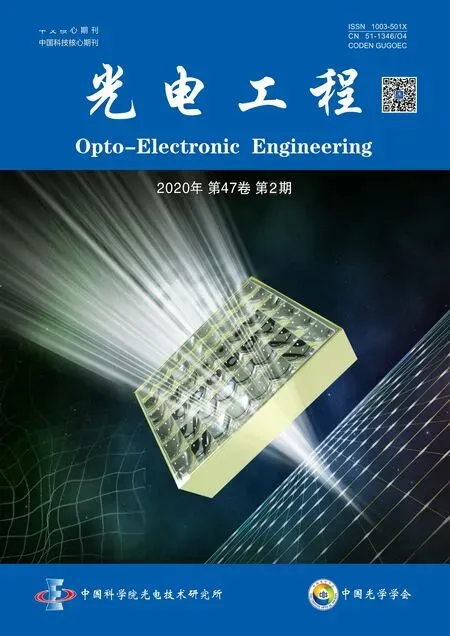高效非成像聚光光学系统设计与性能分析
茹占强,宋贺伦,吴 菲,宋盛星,朱 煜,殷志珍,刘登科,张耀辉
高效非成像聚光光学系统设计与性能分析
茹占强,宋贺伦*,吴 菲,宋盛星,朱 煜,殷志珍,刘登科,张耀辉
中国科学院苏州纳米技术与纳米仿生研究所系统集成与IC设计研究部,江苏 苏州 215123
针对菲涅尔透镜存在实际光学效率偏低的问题,本文设计了一种由非球面透镜和棒锥镜组成的高效非成像聚光光学系统。在光学设计软件Zemax的序列模式下对非球面透镜进行了优化设计,通过最大程度地减小球差,像面光斑的几何半径从42 mm降到了1.7 mm。基于此,在Zemax的非序列模式下,完成了非球面透镜和棒锥镜的建模和优化,通过蒙特卡罗光线追迹分析实现了光学效率为87%、接收角为0.9°的非成像聚光光学系统。最后,基于非球面透镜阵列和棒锥镜样品,实现了高倍聚光型光伏模组的封装与测试。测试结果表明,该模组的光电转换效率达30.03%,与菲涅尔透镜构成的高倍聚光型光伏模组相比有显著提升。
菲涅尔透镜;非成像聚光光学系统;非球面透镜;聚光型光伏
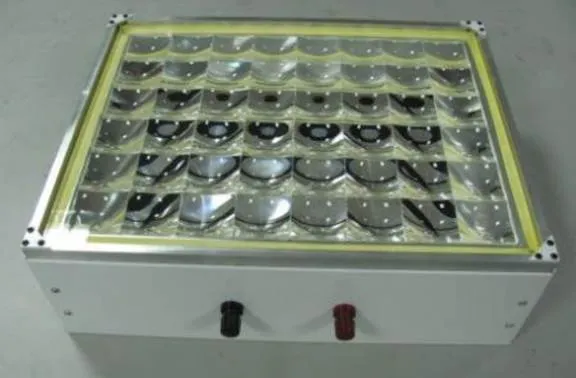
1 引 言
当前,聚光型光伏发电技术被认为是最有可能降低发电成本的技术之一[1]。聚光型光伏发电技术用聚光器把大面积的阳光会聚到小面积的光伏电池表面,实现用廉价的光学材料代替昂贵的光伏电池材料的目的,适合应用于太阳直接辐射强度高的区域[2]。聚光器的选型与优化设计是聚光型光伏领域必须解决的关键问题之一。菲涅尔透镜具有轻薄、低成本的特点,从而成为聚光型光伏领域聚光器的首选。付蕊等开发出一种高效均匀聚光菲涅尔透镜,聚光效率大于80%,在此基础上集成的聚光型光伏模组效率达27.9%[3]。Ferrer-Rodríguez等研究了菲涅尔透镜与不同二次聚光器组成的高倍聚光系统对聚光型光伏模组效率的影响,聚光模组的最高效率达到了28%[4]。
菲涅尔透镜从原理上可以达到较高的光学效率,但是由于圆角散射、脱模形变、齿根遮光等加工工艺条件的限制[5],实际运行时光学效率会大幅降低,限制了聚光型光伏模组光电转换效率的进一步提升。非球面透镜不存在此类加工工艺限制,且非球面面型可以有效降低像差、提升聚光效率[6-7]。为此,本文创新性地提出用非球面透镜来代替菲涅尔透镜的理念,设计了一种由非球面透镜和棒锥镜组成的高效非成像聚光光学系统。在此基础上,集成微型三结砷化镓光伏电池,实现了高倍聚光型光伏模组样机的研制与性能分析。
2 工作原理
基于非球面透镜的高效非成像聚光光学系统由作为主聚光器的非球面透镜和作为二次聚光器的棒锥镜组成,入射光线被非球面透镜会聚到棒锥镜的上端面,经棒锥镜的二次会聚入射到光伏电池的表面,如图1所示。
主聚光器的面积和光伏电池的面积之比称为几何聚光比,几何聚光比与非成像聚光光学系统的光学效率乘积称为能量聚光比,能量聚光比越高代表光伏电池表面能量密度越高,最佳能量聚光比的设计根据光伏电池的聚光特性而定。当前,高倍聚光型光伏模组普遍采用边长为5.5 mm或者10 mm的多结砷化镓光伏电池,最佳能量聚光比一般都在几百倍甚至上千倍,相应主聚光器孔径在十几到几十厘米,在保证合理厚度的前提下只能选用菲涅尔透镜。为了实现非球面透镜取代菲涅尔透镜,并且,厚度控制在合理范围,必须缩小光伏电池的尺寸。为此,我们开发出了直径只有2.5 mm微型三结砷化镓光伏电池,图2为该光伏电池的截面图。
图3为该微型三结砷化镓光伏电池的光电转换效率随能量聚光比变化曲线,可知,该电池在能量聚光比为330倍时,光电转换效率可以达到最大值。非成像聚光光学系统包含非球面透镜和棒锥镜两个光学元件,即四个光学界面,系统理想的光学效率在84%左右,考虑加工误差和聚光模组的封装、对准误差,有效的光学效率大约在80%左右。因此,高倍聚光型光伏模组的几何聚光比约为413倍,考虑高倍聚光型光伏模组的封装要求,非球面透镜要切成正方形再胶合成阵列结构,所以非球面透镜的孔径应为64 mm,切割后的内接正方形非球面透镜的边长为45 mm。
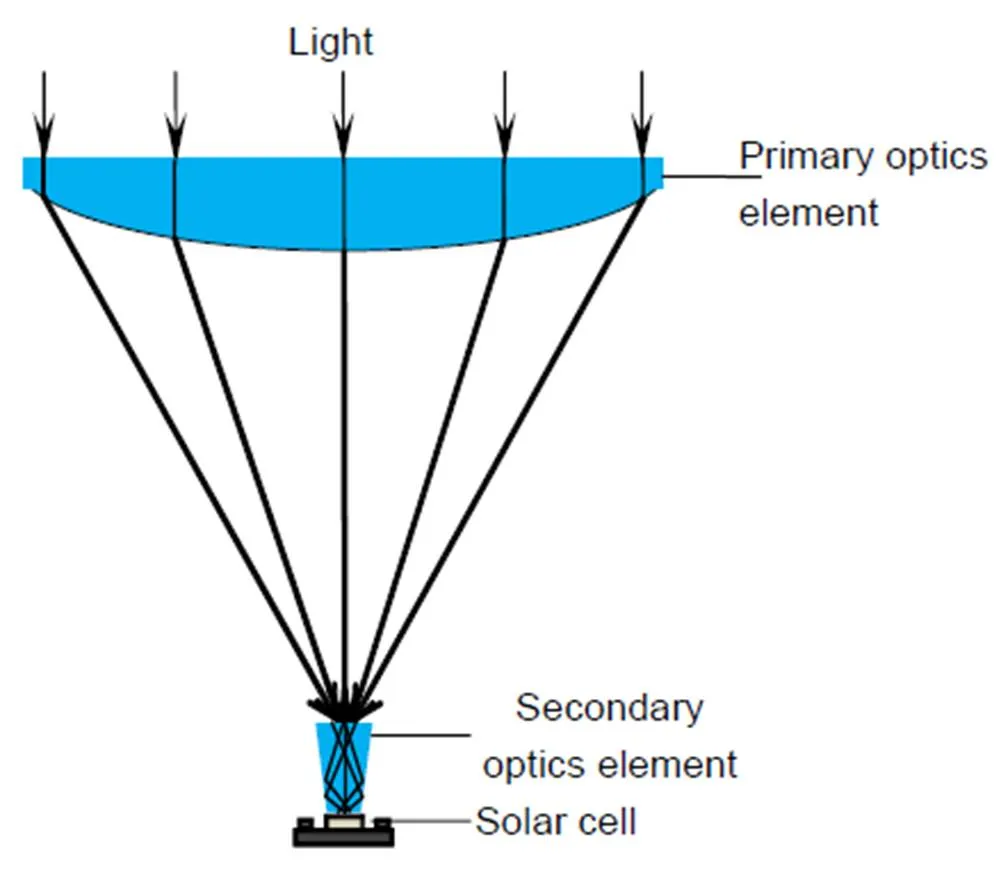
图1 高效非成像聚光光学系统原理图
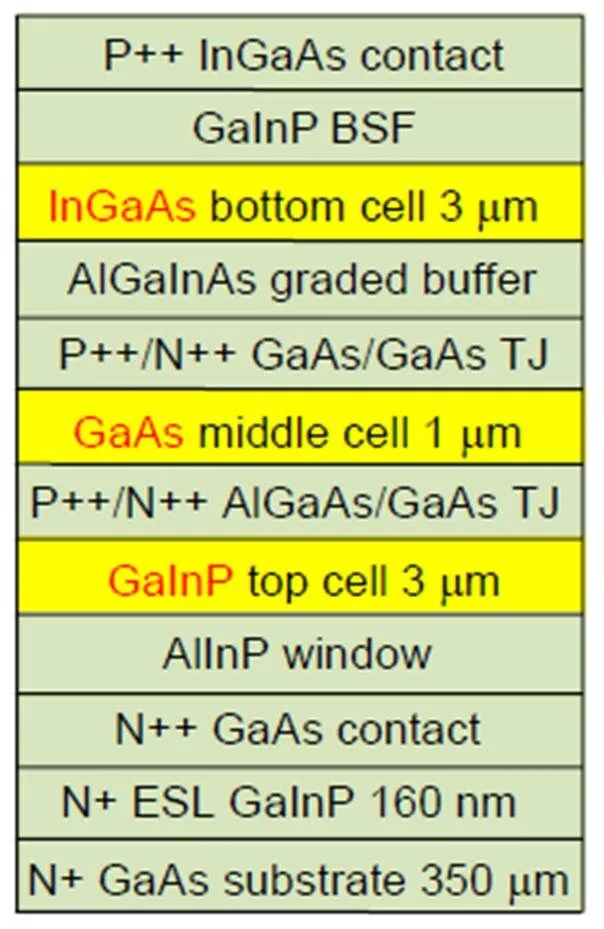
图2 微型三结砷化镓光伏电池截面图
3 非球面透镜设计
3.1 初始结构模型建立
由上节可知,透镜的孔径为64 mm,为了兼顾聚光效率和系统紧凑性,设置透镜的/#为1,则焦距值为´/#=64 mm。波长范围根据三结砷化镓光伏电池响应特性为348 nm~1860 nm,主波长为540 nm,视场范围为0°,透镜材料选取常用的BK7光学玻璃。为了满足实际应用需求,选取透镜第一个面为光阑,并设置为平面,第二个面曲率的求解类型设置为/#=1。球面透镜的初始结构参数如表1所示。

表1 球面透镜的初始结构参数
3.2 初始结构像差分析
该球面透镜的塞德尔像差系数和点列图如表2和图4所示,其中,Surf、STO和IMA分别代表面型、光阑面和像面,SPHA、COMA、ASTI、FCUR、DIST、CLA和CTR分别代表球差、彗差、像散、场曲、畸变、轴向色差和垂轴色差。
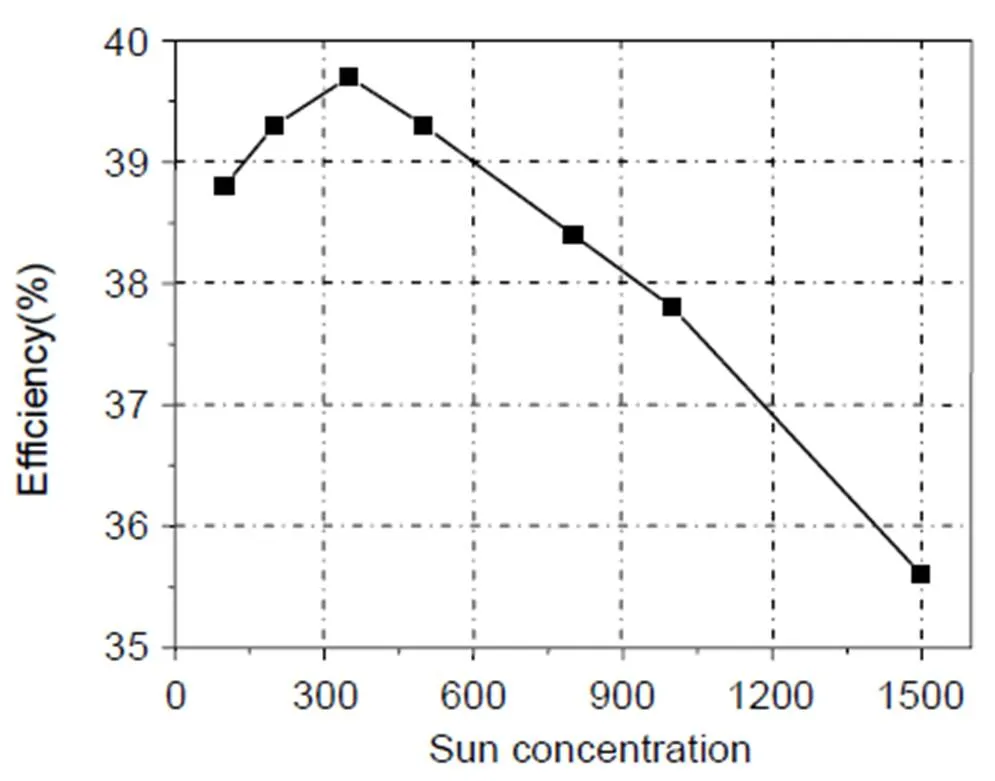
图3 微型三结砷化镓光伏电池光电转换效率随聚光比变化曲线
由表2可知,初始结构的球差SPHA值很大为34.26,在很大程度上影响了系统的聚焦光斑质量,如图4光斑点列图所示,像面光斑的几何半径高达42 mm,是三结砷化镓光伏电池的33.6倍。为了有效降低系统球差,减小像面光斑的几何半径,使更多光能入射到三结砷化镓光伏电池表面,将透镜的第二个面设置成偶次非球面[8-9],并设置球差和焦距为优化操作函数,非球面曲率、厚度、后焦距、非球面系数和高阶系数为变量,进行软件自动优化。
3.3 优化结果及像差分析
优化后的非球面透镜点列图和塞德尔像差系数如图5和表3所示。
由表3可知,优化后的非球面透镜球差SPHA的值接近于0.1,极大地改善了成像质量,如图5光斑点列图所示,像面上的光斑几何半径也减小到了1.7 mm,基本接近三结砷化镓光伏电池半径。优化后的非球面透镜结构参数如表4所示。

表2 初始结构的塞德尔像差系数
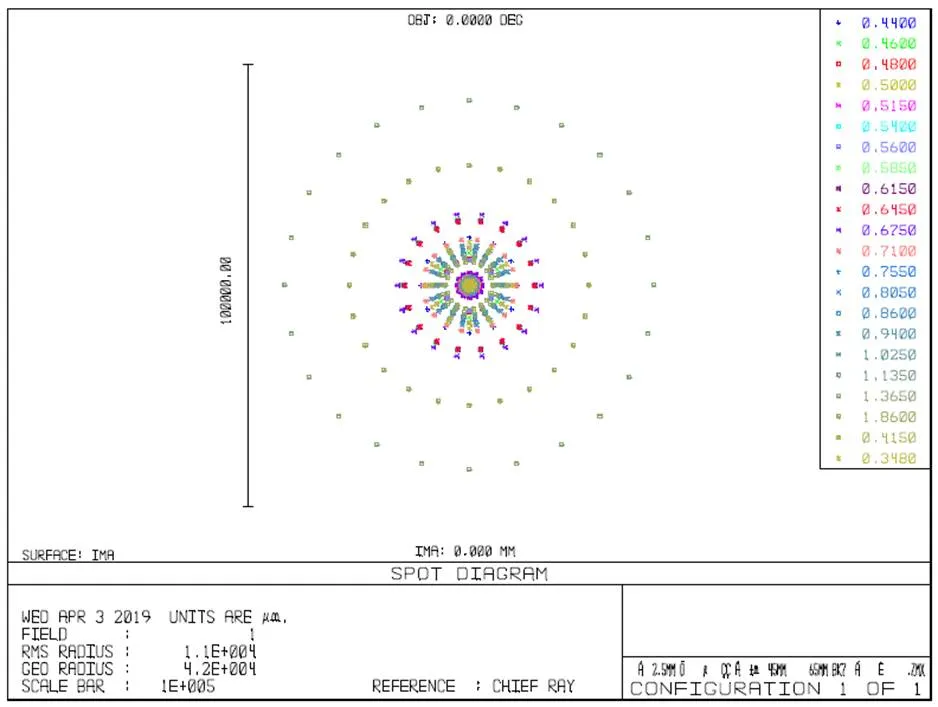
图4 初始结构聚焦光斑点列图
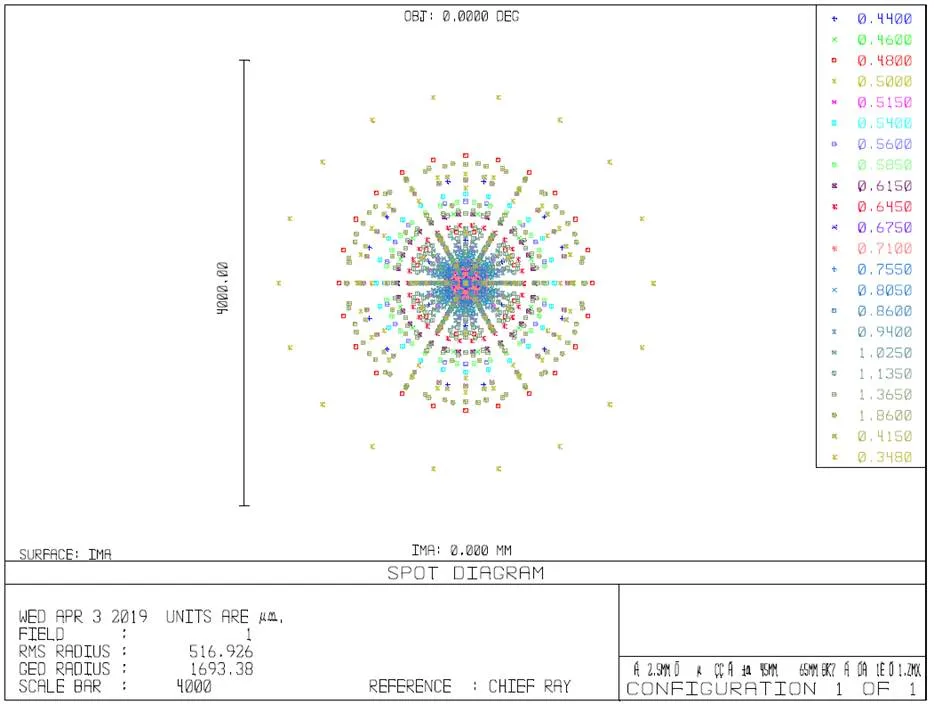
图5 非球面透镜聚焦光斑点列图

表3 非球面透镜的塞德尔像差系数

表4 非球面透镜结构参数
4 棒锥镜设计与光学系统性能分析
在Zemax软件的非序列模式下对上节设计的非球面透镜进行建模,同时,建立模拟太阳的标准光源模型和探测器模型,如表5和表6所示。
棒锥镜主要有3个作用:1) 使像面光斑的几何半径与三结砷化镓光伏电池相匹配;2) 在光线偏折入射的情况下使光线尽可能多地入射到三结砷化镓光伏电池表面;3) 使三结砷化镓光伏电池表面的辐照度更均匀[10]。
由非成像聚光光学系统原理,棒锥镜的上端面半径大于非球面透镜焦点处光斑的几何半径,下端面半径与三结砷化镓光伏电池相匹配,考虑装配误差的因素,在此设置为1.2 mm,初始高度可以随意设置为一个合理值,表7为该棒锥镜的初始结构参数。
完成初始结构建模后,将棒锥镜上端面置于非球面透镜的焦点位置,探测器位于棒锥镜下端面位置。
以棒锥镜上端面半径、高度为变量,以探测器收集到的能量和光斑分布均匀性为评价函数,利用蒙特卡罗光线追迹的方法进行优化,得到棒锥镜的最优结构参数如表8所示,图6为基于最优结构棒锥镜的非成像聚光光学系统光路图。

表5 标准光源参数

表6 探测器参数
基于最优结构,对不同入射条件下非成像聚光光学系统的聚光效率和聚光效果进行蒙特卡罗光线追迹分析,如图7所示,可知该系统在光线垂直入射时的光学效率为87%,在光线入射角为0.9°时的光学效率为79.2%,接近且大于垂直入射时光学效率的90%,所以该系统的接收角为0.9°。

表7 棒锥镜初始结构参数

表8 棒锥镜最优结构参数
为了对比,同样对不同入射条件下单非球面透镜的聚光效率和聚光效果进行了蒙特卡罗光线追迹分析,如图8所示。可见在没有棒锥镜的情况下,光线垂直入射时的光学效率为87.4%;入射光线偏折0.9°时,系统的光学效率大幅下降到40%。所以,非成像聚光光学系统必须包含二次聚光器,同时,高精度的太阳能跟踪控制系统也是不可或缺的[11-12]。
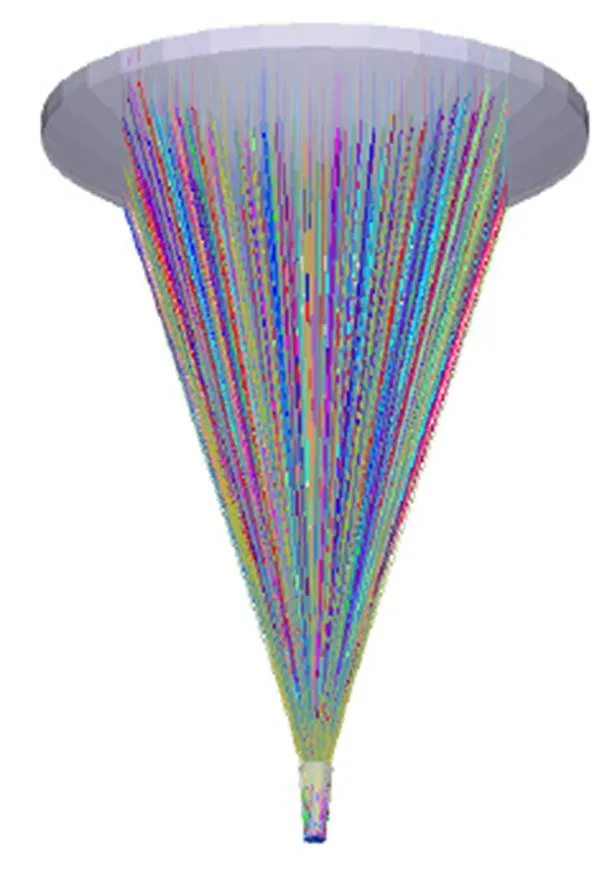
图6 最优结构的非成像聚光光学系统的光路图

图7 不同入射条件下光学系统聚焦光斑辐照度分布。(a) 光线垂直入射时;(b) 光线入射角为0.9°时

图8 不同入射条件下非球面透镜聚焦光斑辐照度分布。(a) 光线垂直入射时;(b) 光线入射角为0.9°时
为了验证该非成像聚光光学系统的聚光性能,在光线入射角为0°的条件下,对单非球面透镜和非成像聚光光学系统进行了蒙特卡罗光线追迹对比分析,结果如图9所示。单非球面透镜的焦面光斑辐照度呈高斯分布状态,中心点强度峰值高达111.18 W/cm2,边缘点强度值为0.99 W/cm2,焦面光斑的辐照分布均匀性为1-(111.18-0.99)/(111.18+0.99)=1.77%,非成像聚光光学系统的焦面光斑辐照度分布更均匀,中心点强度峰值降低至32.19 W/cm2,边缘点强度值为11.73 W/cm2,焦面光斑的辐照分布均匀性为1-(32.19-11.73)/(32.19+11.73)=53.42%。可见,二次聚光器可以有效改善焦面光斑辐照度分布均匀性,有利于三结砷化镓光伏电池光电效率的提升。
5 高倍聚光型光伏模组封装与测试
为了满足聚光型光伏模组的封装需求,加工时要把非球面透镜切割成正方形,然后胶合到硼硅玻璃基底上,形成6´8阵列,如图10所示。同时,基于光学冷加工工艺完成了对棒锥镜样品的加工,如图11所示。在此基础上,实现了基于非球面透镜的高倍聚光型光伏模组样品的封装,如图12所示。
为了验证该高倍聚光型光伏模组的光电性能,在标准条件下(AM1.5D光谱、1000 W/m2辐照度、=25 ℃)对其进行了I-V性能测试,结果如图13所示。作为对比,在相同条件下对主聚光器为菲涅尔透镜的高倍聚光型光伏模组(如图14所示)进行了I-V性能测试,结果如图15所示。测试结果表明,基于非球面透镜的模组光电转换效率达到了30.03%,大幅高于基于菲涅尔透镜的模组25.04%的光电转换效率,可见,非球面透镜取代菲涅尔透镜能显著提升非成像聚光光学系统的聚光效率。

图9 入射角为0°时不同系统聚焦光斑辐照度分布图。(a) 单非球面透镜;(b) 非成像聚光光学系统
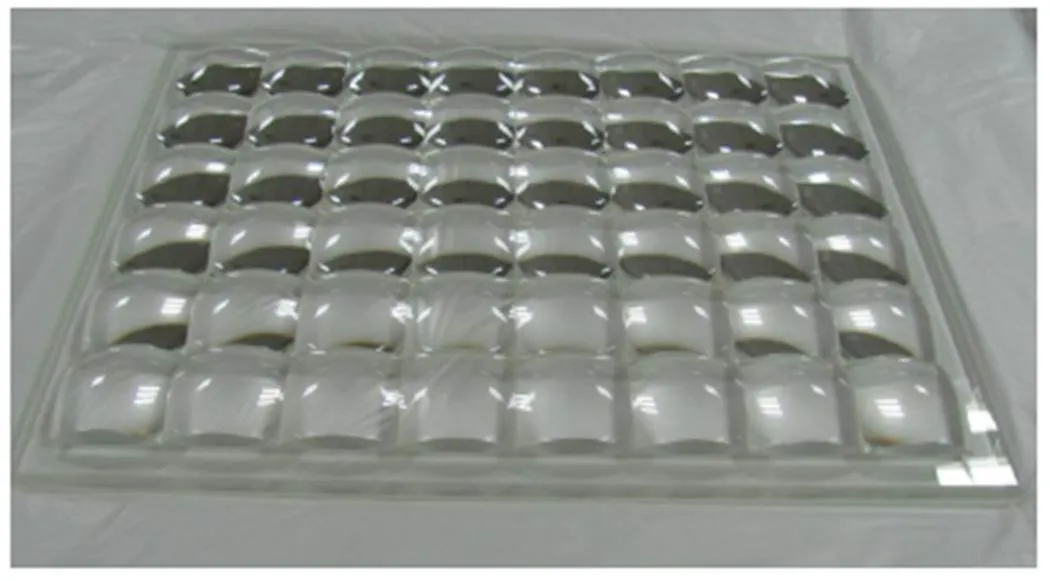
图10 非球面透镜阵列样品
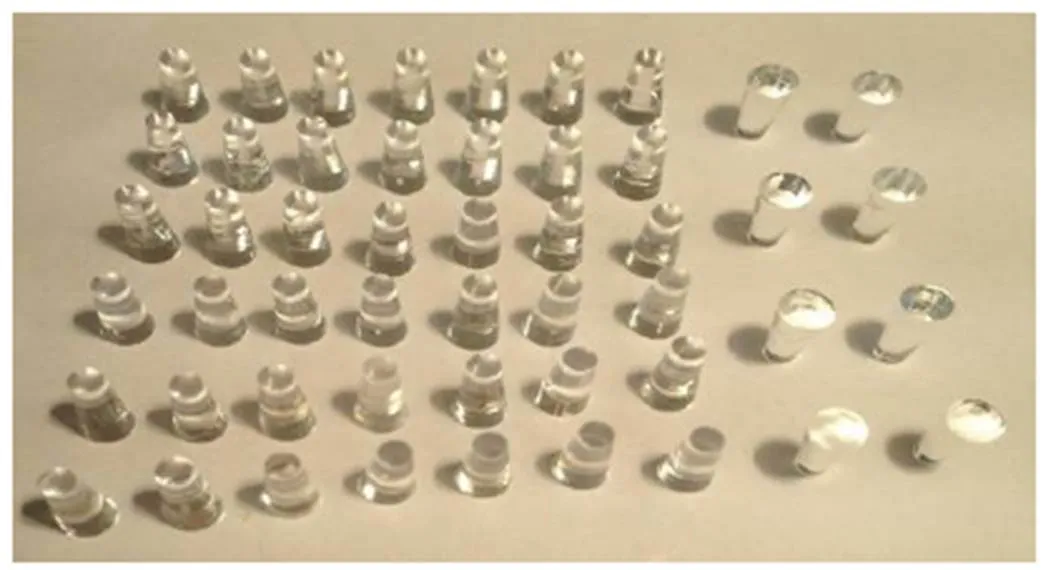
图11 棒锥镜样品
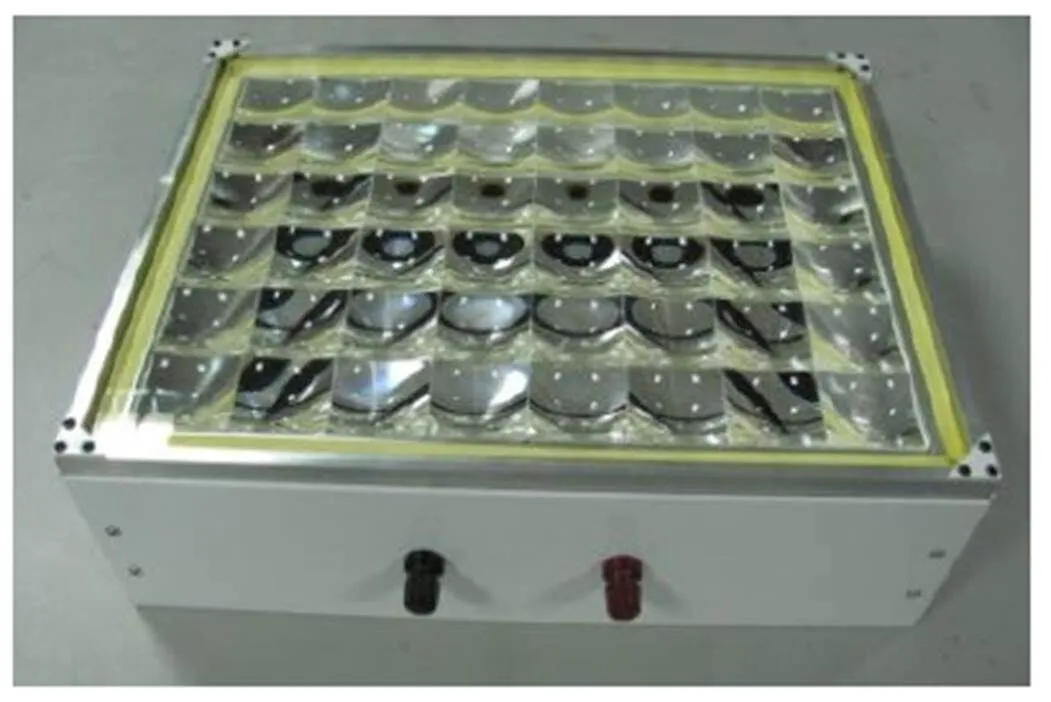
图12 基于非球面透镜的高倍聚光型光伏模组样品
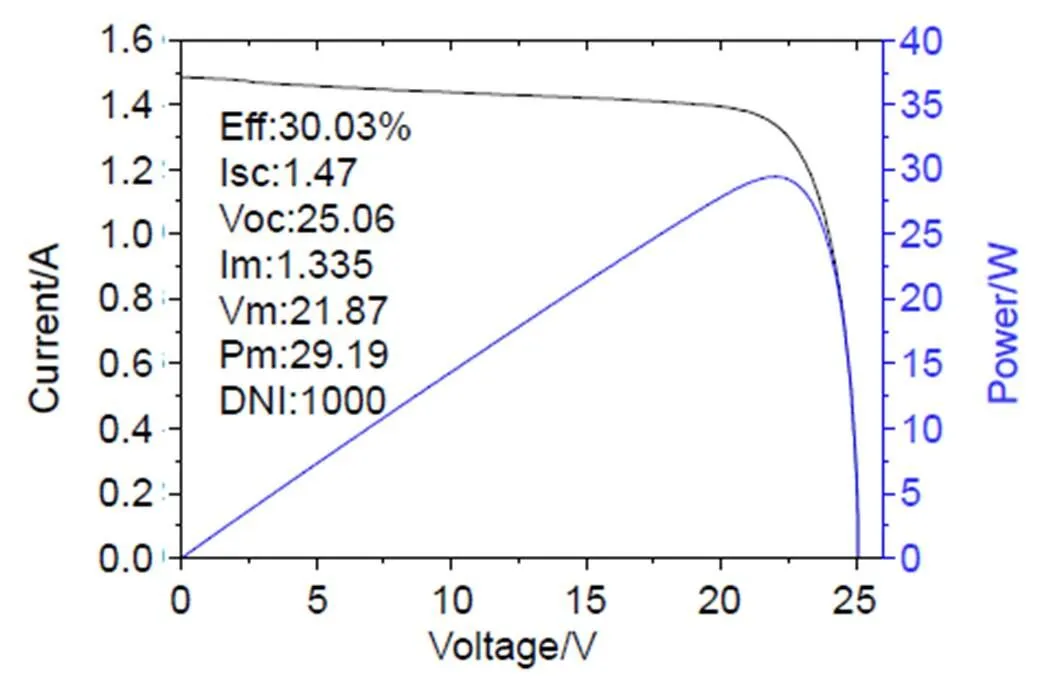
图13 基于非球面透镜的高倍聚光型光伏模组I-V特性
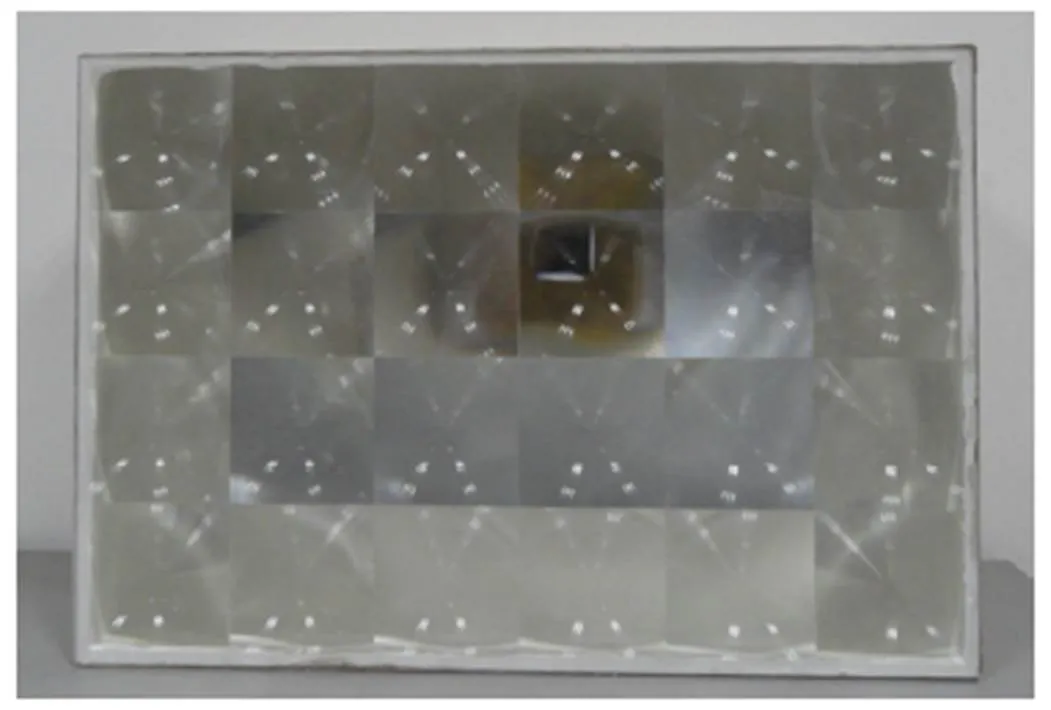
图14 基于菲涅尔透镜的高倍聚光型光伏模组样品
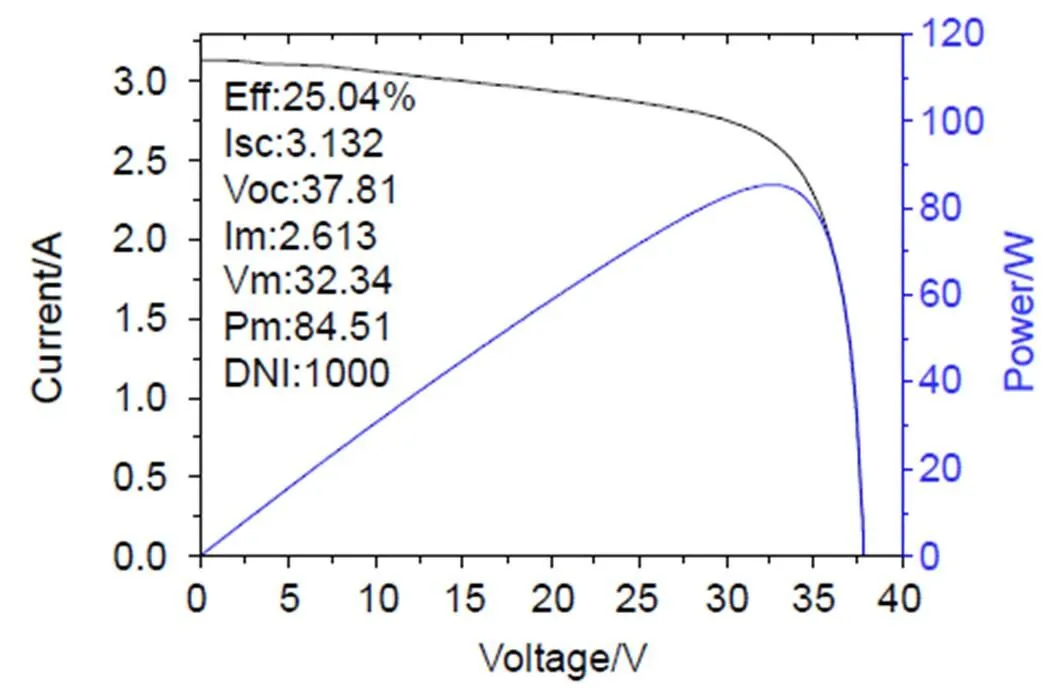
图15 基于菲涅尔透镜的高倍聚光型光伏模组I-V特性
6 结 论
非球面透镜可以大幅减小系统球差,改善成像像质,减小像面光斑的几何半径,结合优化的棒锥镜可以实现非成像聚光光学系统聚光效率的大幅提升,同时,可以增大高倍聚光光伏系统的接收角,改善光伏电池表面辐照度分布的均匀性,显著提升高倍聚光型光伏模组的光电转换效率。然而,由于客观原因多结砷化镓光伏电池的几何尺寸仍然偏大,在保证一定能量聚光比的条件下,非球面透镜孔径无法进一步降低,厚度仍然偏厚,不利于实际工程应用。未来,随着多结砷化镓光伏电池进一步小型化和非球面透镜阵列模压技术的进一步成熟,这种由非球面透镜和棒锥镜组成的高效非成像聚光光学系统在高倍聚光型光伏发电领域将会有广阔的应用前景。
[1] Burhan M, Chua K J E, Ng K C. Simulation and development of a multi-leg homogeniser concentrating assembly for concentrated photovoltaic (CPV) system with electrical rating analysis[J]., 2016, 116: 58–71.
[2] Rajaee M, Ghorashi S M B. Experimental measurements of a prototype high-concentration Fresnel lens and sun-tracking method for photovoltaic panel’s efficiency enhancement[J]., 2015, 9(4): 251–259.
[3] Fu R. Optimization design of Fresnel concentrator and application research in concentrator photovoltaic technology[D]. Beijing: North China Electric Power University, 2017.
付蕊. Fresnel聚光器的优化设计及其在聚光光伏中的应用研究[D]. 北京: 华北电力大学, 2017.
[4] Ferrer-Rodríguez J P, Fernández E F, Baig H,. Development, indoor characterisation and comparison to optical modelling of four Fresnel-based high-CPV units equipped with refractive secondary optics[J]., 2018, 186: 273–283.
[5] Hai D P. Research on fabricating process of Fresnel lens[D]. Harbin: Harbin Institute of Technology, 2007.
海大鹏. 菲涅尔透镜的加工工艺研究[D]. 哈尔滨: 哈尔滨工业大学, 2007.
[6] Roy A C, Yadav M, Khanna A,. Bi-convex aspheric optical lenses[J]., 2017, 110(10): 103701.
[7] Wang Z M, Qu W J, Asundi A. A simplified expression for aspheric surface fitting[J]., 2017, 140: 291–298.
[8] Feng K, Li J S. Design of aspherics lenses shaping system on Gaussian beam[J]., 2013, 40(5): 127–132.
冯科, 李劲松. 高斯光束非球面镜整形系统的设计[J]. 光电工程, 2013, 40(5): 127–132.
[9] Mo W D, Fu Z T, Fan Q,. Determining the best-fit spherical surface and asphericity of aspheric surface by calculating the fringe density[J]., 2012, 39(12): 7–11.
莫卫东, 傅振堂, 范琦, 等. 确定非球面最佳参考球面及非球面度的一种新方法[J]. 光电工程, 2012, 39(12): 7–11.
[10] Yeh N. Illumination uniformity issue explored via two-stage solar concentrator system based on Fresnel lens and compound flat concentrator[J]., 2016, 95: 542–549.
[11] Obara S, Matsumura K, Aizawa S,. Development of a solar tracking system of a nonelectric power source by using a metal hydride actuator[J]., 2017, 158: 1016–1025.
[12] Yang C K, Cheng T C, Cheng C H,. Open-loop altitude-azimuth concentrated solar tracking system for solar-thermal applications[J]., 2017, 147: 52–60.
Design and performance analysis of high efficiency non-imaging concentrated optical system
Ru Zhanqiang, Song Helun*, Wu Fei, Song Shengxing, Zhu Yu, Yin Zhizhen, Liu Dengke, Zhang Yaohui
System Integration & IC Design Division, Suzhou Institute of Nano-tech and Nano-bionics, Chinese Academy of Sciences, Suzhou, Jiangsu 215123, China
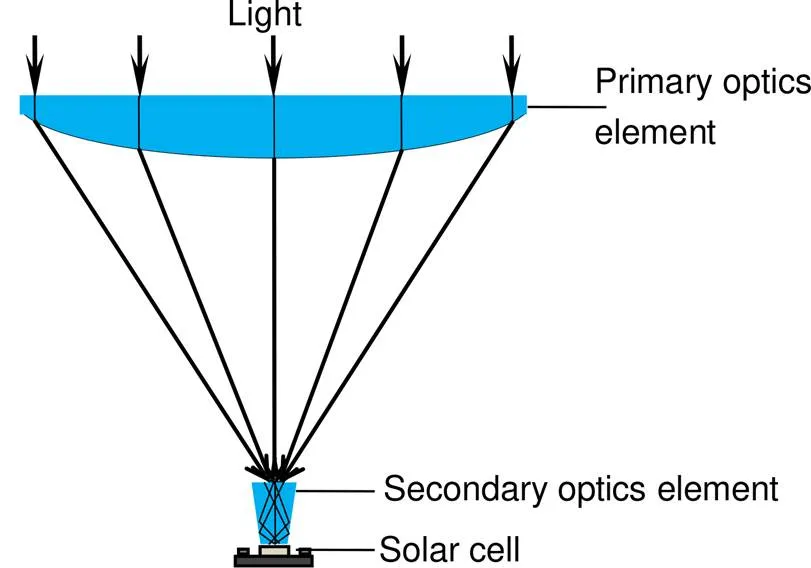
Principle of high efficiency non-imaging concentrated optical system
Overview:Nowadays, Fresnel lens was widely used as the primary optics element in high concentrated photovoltaic module. In principle, the optical efficiency of Fresnel lens could be high. However, it will decrease sharply due to the limitation of processing technology, for example, scattering of angle of chamfer, the deformation of demoulding, the shading of tooth root, and so on. These issues influence the further improvement of photoelectric conversion efficiency of high concentrated photovoltaic module. Consequently, the idea of replacing Fresnel lens with aspheric lens was proposed innovatively and a high-efficiency non-imaging concentrated optical system composed of an aspheric lens array and 48 trumpet lenses was designed. Firstly, the initial structure parameters of the aspheric lens were determined according to the characteristics of micro-scale three-junction GaAs solar cell. The aspheric lens was optimized in sequential mode of Zemax on the basis of aberration analysis of the initial structure, and the geometric radius of its image spot was reduced from 42 mm to 1.7 mm and the value of SPHA was reduced from 34.26 to 0.1 by minimizing the spherical aberration. The standard light source, detector, aspheric lens and trumpet lens were modeled in non-sequential mode of Zemax, and the trumpet were optimized by altering the radius of upper surface and the height. The high-efficiency non-imaging concentrated optical system with 87% optical efficiency and 0.9° received angle was achieved by Monte Carlo ray tracing analysis. On the basis, the high-efficiency non-imaging concentrated optical system and single aspheric lens were analyzed comparatively. The analysis results showed that the efficiency of single aspheric lens reduced from 87.4% to 40% when the incident angle increased from 0 to 0.9 degrees, and yet the efficiency of the high-efficiency non-imaging concentrated optical system still reached 79.2%. In addition, the irradiance distribution uniformity of the focal spot of the single aspheric lens was 1.77%, and the value of the high-efficiency non-imaging concentrated optical system was up to 53.42%. Finally, the packaging and test of high concentrated photovoltaic modules based on the high-efficiency non-imaging concentrated optical system and Fresnel lens were completed separately. The results of test comparatively showed that the photoelectric conversion efficiency of the module based on Fresnel lens was 25.04%, and the photoelectric conversion efficiency of the module based on the high-efficiency non-imaging concentrated optical system was up to 30.03%, which was significantly improved compared with the high concentrated photovoltaic module composed of the Fresnel lens.
Citation: Ru Z Q, Song H L, Wu F,Design and performance analysis of high efficiency non-imaging concentrated optical system[J]., 2020, 47(2): 190203
Design and performance analysis of high efficiency non-imaging concentrated optical system
Ru Zhanqiang, Song Helun*, Wu Fei, Song Shengxing, Zhu Yu, Yin Zhizhen, Liu Dengke, Zhang Yaohui
System Integration & IC Design Division, Suzhou Institute of Nano-tech and Nano-bionics, Chinese Academy of Sciences, Suzhou, Jiangsu 215123, China
Aiming at the low optical efficiency of Fresnel lens, a high-efficiency non-imaging concentrated optical (NICO) system composed of an aspheric lens and a trumpet lens was designed. The aspheric lens was optimized in sequential mode of Zemax, and the geometric radius of its image spot was reduced from 42 mm to 1.7 mm by minimizing the spherical aberration. The aspheric lens and trumpet lens were modeled and optimized in non-sequential mode of Zemax, and the NICO system with 87% optical efficiency and 0.9° received angle was achieved by Monte Carlo ray tracing analysis. Finally, the packaging and testing of the high concentrated photovoltaic (HCPV) module were completed based on samples of an aspheric lens array and 48 trumpet lenses. The test results showed that the photoelectric conversion efficiency of the module reached 30.03%, which was significantly improved compared with the HCPV module composed of the Fresnel lens.
Fresnel lens; non-imaging concentrated optical system; aspheric lens; concentrated photovoltaic
Supported by National Key R&D Program of China (2016YFE0129400) and Youth Innovation Promotion Association Talent Fund, CAS (2016290)
TM615
A
10.12086/oee.2020.190203
: Ru Z Q, Song H L, Wu F,. Design and performance analysis of high efficiency non-imaging concentrated optical system[J]., 2020,47(2): 190203
2019-04-24;
2019-05-14
国家重点研发计划(2016YFE0129400);中国科学院青年创新促进会人才资助计划(2016290)
茹占强(1982-),男,硕士,高级工程师,主要从事聚光型光伏及光学系统的研究。E-mail:zqru2008@sinano.ac.cn
宋贺伦(1980-),男,博士,研究员,主要从事聚光型光伏技术、半导体器件集成等方面的研究。E-mail:hlsong2008@sinano.ac.cn
茹占强,宋贺伦,吴菲,等. 高效非成像聚光光学系统设计与性能分析[J]. 光电工程,2020,47(2): 190203
* E-mail: hlsong2008@sinano.ac.cn

